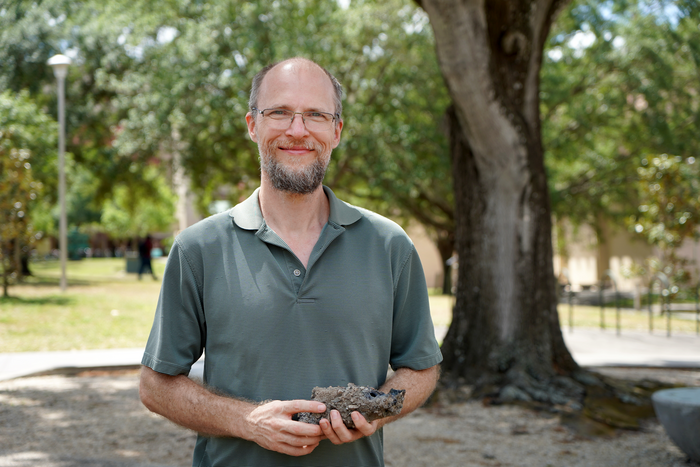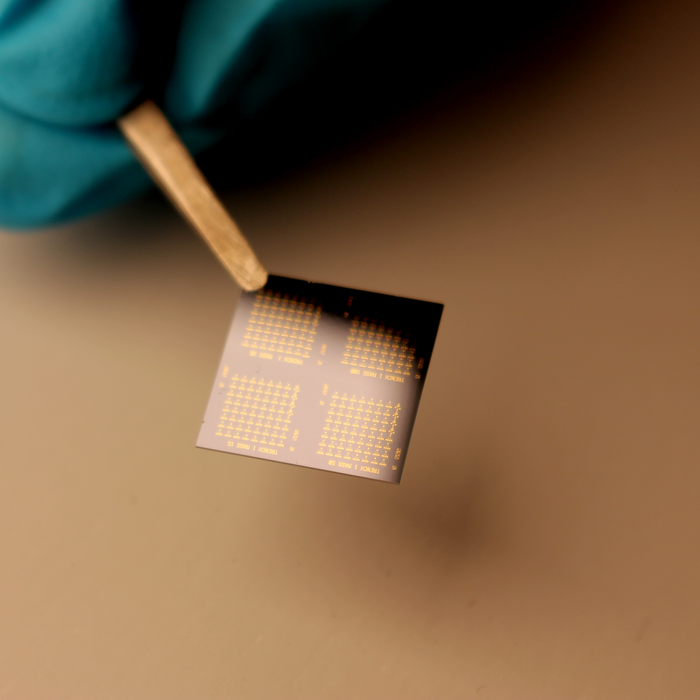TAMPA, Fla. (April 11, 2023) – After lightning struck a tree in a New Port Richey neighborhood, a University of South Florida professor discovered the strike led to the formation of a new phosphorus material. It was found in a rock – the first time in solid form on Earth – and could represent a member of a new mineral group.

Credit: Matthew Pasek/University of South Florida
TAMPA, Fla. (April 11, 2023) – After lightning struck a tree in a New Port Richey neighborhood, a University of South Florida professor discovered the strike led to the formation of a new phosphorus material. It was found in a rock – the first time in solid form on Earth – and could represent a member of a new mineral group.
“We have never seen this material occur naturally on Earth – minerals similar to it can be found in meteorites and space, but we’ve never seen this exact material anywhere,” said geoscientist Matthew Pasek.
In a recent study published in Communications Earth & Environment, Pasek examines how high-energy events, such as lightning, can cause unique chemical reactions, and in this instance, result in a new material – one that is transitional between space minerals and minerals found on Earth.
“When lightning strikes a tree, the ground typically explodes out and the surrounding grass dies, forming a scar and sending electric discharge through nearby rock, soil and sand, forming fulgurites, also known as ‘fossilized lightning’,” Pasek said.
When the New Port Richey homeowners discovered the ‘lightning scar’, they found a fulgurite and decided to sell it, assuming it had value. Pasek purchased it, and later began a collaboration with Luca Bindi, a professor of mineralogy and crystallography at the University of Florence in Italy.
Together, the team set out to investigate unusual minerals that bear the element phosphorus, especially those formed by lightning, to better understand high-energy phenomena.
“It’s important to understand how much energy lightning has because then we know how much damage a lightning strike can cause on average and how dangerous it is,” Pasek said. “Florida is the lightning capital of the world and lightning safety is important – if lightning is strong enough to melt rock, it can certainly melt people too.”
In wet environments, such as in Florida, Pasek says iron will often accumulate and encrust tree roots. In this case, not only did the lightning strike combust the iron on the tree roots, but it combusted the naturally occurring carbon in the tree as well. The two elements led to a chemical reaction that created a fulgurite that looked like a metal ‘glob.’
Inside the fulgurite, a colorful, crystal-like matter revealed a material never before discovered.
Co-principal investigator Tian Feng, a graduate of USF’s geology program, attempted to remake the material in a lab. The experiment was unsuccessful and indicates the material likely forms quickly under precise conditions, and if heated too long, will turn into the mineral found in meteorites.
“Previous researchers indicate that lightning reduction of phosphate to have been a widespread phenomenon on the early Earth,” Feng said. “However, there is an environmental phosphite reservoir issue in Earth that these solid phosphite materials are hard to restore.”
Feng says this research may reveal other forms of reduced minerals are plausible and many could have been important in the development of life on Earth.
According to Pasek, it’s unlikely this material could be mined for uses similar to other phosphates, such as fertilizer, given the rarity of it occurring naturally. However, Pasek and Bindi plan to further investigate the material to determine if it could be officially declared a mineral and bring additional awareness to the scientific community.
###
About the University of South Florida
The University of South Florida, a high-impact global research university dedicated to student success, generates an annual economic impact of more than $6 billion. Over the past 10 years, no other public university in the country has risen faster in U.S. News and World Report’s national university rankings than USF. Serving more than 50,000 students on campuses in Tampa, St. Petersburg and Sarasota-Manatee, USF is designated as a Preeminent State Research University by the Florida Board of Governors, placing it in the most elite category among the state’s 12 public universities. USF has earned widespread national recognition for its success graduating under-represented minority and limited-income students at rates equal to or higher than white and higher income students. USF is a member of the American Athletic Conference. Learn more at www.usf.edu.
Journal
Nature Communications
Method of Research
Observational study
Subject of Research
Not applicable
Article Title
Routes to reduction of phosphate by high-energy events
Article Publication Date
14-Mar-2023





